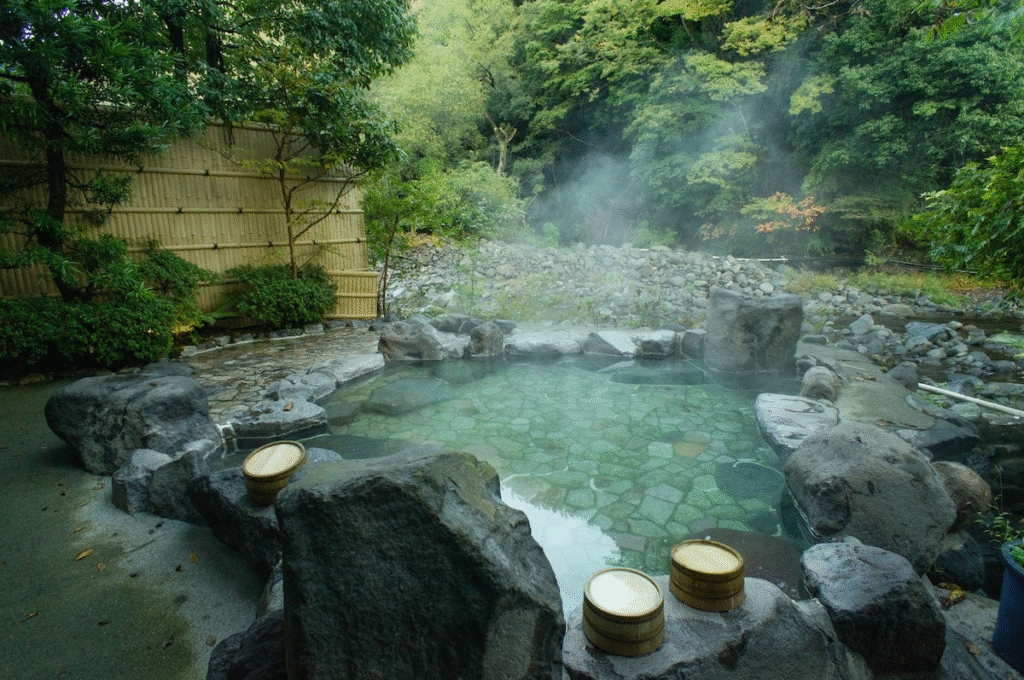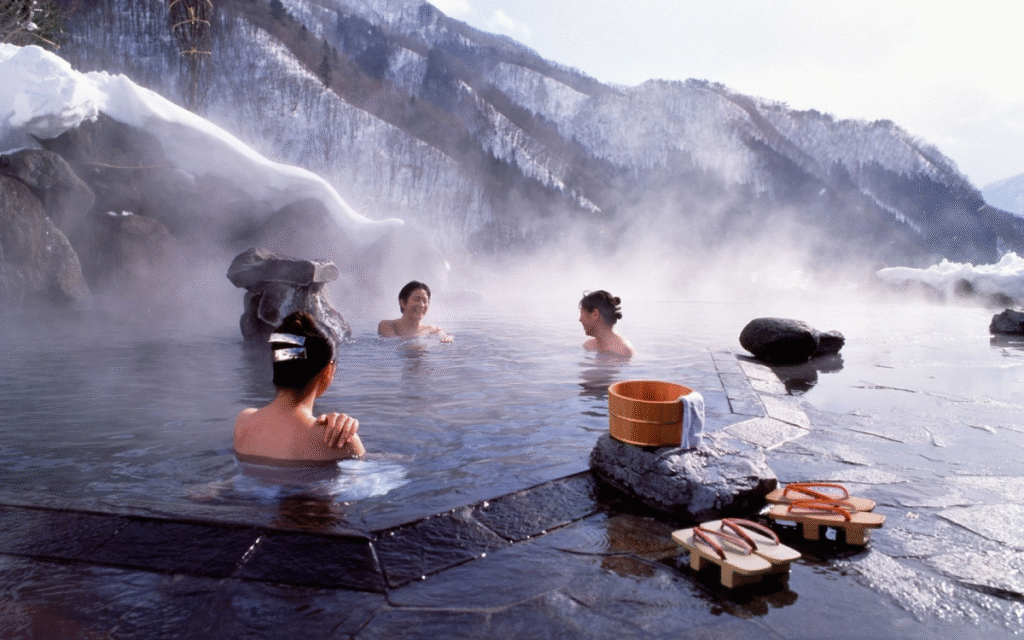There’s something almost otherworldly about sinking into a Japanese hot spring — steam rising through mountain air, the scent of minerals, the quiet sound of running water. But for first-timers, visiting an onsen (温泉) can feel intimidating. What do you wear? Do you have to be completely naked? What’s the right way to behave?
Relax. Everyone feels awkward the first time, but once you know what to expect, you’ll see why this centuries-old bathing ritual is one of the most calming, unforgettable parts of Japanese culture.
What Is an Onsen?

An onsen is a natural hot spring bath that uses geothermally heated water rich in minerals such as sulfur, sodium, or iron. Japan sits on volcanic ground, so there are thousands of onsens scattered across the country — from mountain villages in Hokkaido to seaside resorts in Kyushu.
People visit onsens to heal, relax, and unwind. The mineral water is believed to improve circulation, ease muscle pain, and soften skin. But beyond the physical benefits, there’s something deeper about it — a sense of stillness and respect for nature that defines Japanese bathing culture.
Before You Go: What to Know

1. Choose Your Type of Onsen
Not all onsens are the same:
- Public onsens are usually gender-separated.
- Ryokan (traditional inns) have private or shared baths for guests.
- Private onsens (貸切風呂, kashikiri-buro) can be rented by couples or families — perfect for those who want privacy.
2. Tattoo Policy
Some onsens still restrict visible tattoos due to old associations with organized crime (yakuza). But don’t worry — many are becoming more open. Look for “tattoo-friendly onsen” or bring waterproof patches to cover small designs.
3. What to Bring
Most facilities provide towels, shampoo, and soap. But if you want to blend in like a local, bring:
- A small towel (for washing and modesty)
- A larger towel (for drying afterward)
- A hair tie if you have long hair
Step-by-Step: How to Bathe Properly

Step 1: Undress Completely
Yes, you bathe naked — everyone does.
Enter the changing room, remove all clothing, and store your belongings in the locker or basket. Keep your small towel with you; it’s your modesty towel.
Step 2: Wash Before Entering
Cleanliness is sacred in Japanese bathing culture.
At the wash station, sit on the small stool and rinse thoroughly from head to toe. Use soap and shampoo generously, rinse off every bubble, and tie your hair up if it’s long. Never skip this step — the onsen water must stay pure.
Step 3: Enter Slowly
Dry yourself lightly before walking to the pool so you don’t drip.
Gently ease into the bath — it’s often hotter than you expect (around 40–43 °C). Don’t splash or swim; just sit, soak, and relax. Rest your towel on your head or the pool’s edge, but never dip it into the water.
Step 4: Soak and Breathe
Once inside, let your body adjust.
The goal isn’t to stay as long as possible — short soaks (10–15 minutes) are perfect. Enjoy the warmth, the minerals, the quiet. Many outdoor baths (rotenburo) overlook forests, rivers, or snowy mountains — it’s hard not to feel at peace.
Step 5: Rinse and Rest
When you’re done, you can lightly rinse (unless signs say not to — some onsens recommend leaving the minerals on your skin). Dry off before re-entering the dressing room. Afterward, sit in the lounge area, sip water or cold milk, and enjoy that post-onsen glow.
Onsen Etiquette Made Easy
| Do | Don’t |
|---|---|
| Wash before entering | Jump or splash |
| Tie up long hair | Bring soap or towel into the water |
| Speak quietly | Take photos in bathing areas |
| Relax and enjoy the silence | Stay too long if you feel dizzy |
| Cover tattoos if required | Eat or drink in the bath area |
What If You’re Shy About Nudity?
It’s completely normal to feel nervous about being naked in front of strangers. But once you step inside, you’ll realize everyone is focused on their own relaxation, not on you. Still, if you prefer privacy:
- Look for private baths (kashikiri-onsen).
- Choose mixed-gender onsens that allow bathing suits (they’re rare, but exist).
- Go early in the morning or on a weekday when it’s quiet.
Remember: for locals, communal bathing is about respect and harmony, not appearance.
Where to Try an Onsen in Japan
- Hakone (near Tokyo) – Famous for its mountain views and variety of outdoor baths.
- Beppu (Oita, Kyushu) – Known as Japan’s “onsen capital,” with hundreds of hot springs.
- Kusatsu (Gunma) – High-altitude resort with milky, sulfuric water and a charming old-town feel.
- Noboribetsu (Hokkaido) – Surrounded by volcanic landscapes and snowy scenery in winter.
- Kurokawa (Kumamoto) – Ideal for travelers seeking a rustic, traditional experience.
Each region has different minerals, water color, and even bathing customs — visiting multiple onsens is like tasting Japan’s geography through water.
Why the Onsen Is More Than a Bath

The Japanese onsen isn’t just about hygiene or relaxation. It’s a window into the country’s values: mindfulness, simplicity, and respect for nature.
There’s something grounding about being surrounded by mountains or forests, feeling the warmth of the earth itself. In those quiet moments — no phone, no rush — you start to understand why locals treat bathing as an almost spiritual ritual.
Quick Tips for First-Timers
- Remove jewelry — minerals can tarnish metal.
- Drink water before and after bathing.
- Stay calm; if it feels too hot, step out and cool off.
- If you have a small towel, rest it on your head — it helps regulate body temperature.
- Don’t worry about your body shape. Everyone comes to relax, not to judge.
Final Thoughts
Once you’ve soaked in an onsen, you’ll never forget it. The warmth seeps into your bones, the stress melts away, and when you step out into the cool air — especially if it’s snowing — it feels like the world just stopped for a moment.
Japan has a way of teaching beauty through simplicity, and the onsen is the perfect example of that.
So don’t overthink it. Take a deep breath, follow the flow, and let the hot spring do the rest.
Discover more from Japan Insider Guide
Subscribe to get the latest posts sent to your email.
